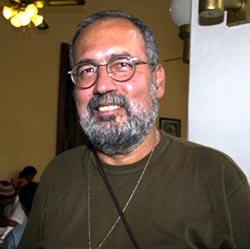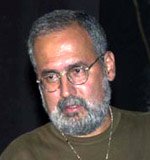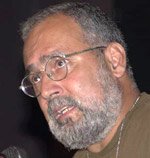


Plan Colombia Extends into Peru
Hugo Cabieses Explains the Wave of Drug War Repression
By Karine Muller
Special to The Narco News Bulletin
April 25, 2003
 Peruvian Economist Hugo Cabieses |
I spoke with Hugo Cabieses, Peruvian economist and expert on the drug issue, who, in a brief visit to Brazil, told us about some of these occurances.
About the Coca Growers’ Protests…
 Hugo Cabieses: Last June, the government signed agreements with the coca farmers regarding the cultivation of coca leaf in Peru. Nils Ericsson, the current drug czar, also signed these agreements that, among other things, stated:
Hugo Cabieses: Last June, the government signed agreements with the coca farmers regarding the cultivation of coca leaf in Peru. Nils Ericsson, the current drug czar, also signed these agreements that, among other things, stated:
- The recognition of two representatives of coca growers’ organizations as valid spokesmen;
- The payment of 350 soles (about $100 US dollars) for each hectare of coca eradicsated, and 1,200 soles (US$350) for every hectare reforested;
- The delivery of credit to farmers, with low taxes, to grow alternative crops such as rice, yucca root, cacao, palm hearts, and coffee.
- The purchase of products by the National Food Assistance Program (Pronaa, in its Spanish initials) and by legal businesses… The farmers accused that, instead of this, the government launched a “forced, violent and repressive” campaign of eradication of coca crops.
For five days last June, fifty farmers came from different regions to discuss these issues in the capital city of Lima. They approached their concerns through technical, political, social and cultural lenses. On June 13th last year, the top Peruvian government authorities, including a foreign relations advisor to President Alejandro Toledo, signed agreements based on these talks..
And later, the very same drug czar Nils Ericsson, of the National Commission for Development of Life Without Drugs (DEVIDA, in its Spanish acronym), threw out the agreements due to pressure from the United States government. This decision seems to have happened together with the recent White House report that cited the increase in coca cultivation in this country. The International Drug Auditing Board put out a press release about “the possibility that Colombian subversive groups will invade our territory to engage in illicit drug trafficking.” And it said that “these subversive groups have been dispersed and have regrouped as narco-trafficking organizations.”
This provoked unrest among farmers who began protests and strikes. They demanded that a high level political commission be formed to enforce compliance with the signed agreements. The government did not form this commission, but, instead, appointed a group of technocrats who had never even been to the jungle regions. When they arrived at the zone, the farmers said that they spoke as if they were the “owner” of the circus but ended up sounding like the “clowns.”
And the owner of this circus, they said, was the U.S. Ambassador. The negotiations never happened. The police repression continued. And the protests followed and expanded to other regional problems in the States. And for the first time in the history of the coca farmers’ struggle, the fight expanded to other regions. And that’s why they are, today, stronger than ever.
The farmers want the government to comply with the agreements it signed. These agreements were not irrational. They were in favor of the fight against narco-trafficking. They were completely reasonable and realistic programs that did not cost a lot of money.
And the government, due to pressure from the United States, did not comply with its agreements. Thus, the strikes, marches, and mobilizations, continue.
About the Extension of Plan Colombia…
 Hugo Cabieses: As the farmers say, “the Colombian problem is Colombia’s problem.” Peru has politics that are completely different. The Peruvian government doesn’t accept the policy of fumigation of coca leaf. Such a policy harms the environment terribly and provokes more problems than it claims to solve. The majority of political groups, including sectors within the government, are not in agreement with the policy of militarizing the anti-drug fight. And the farmers, too.
Hugo Cabieses: As the farmers say, “the Colombian problem is Colombia’s problem.” Peru has politics that are completely different. The Peruvian government doesn’t accept the policy of fumigation of coca leaf. Such a policy harms the environment terribly and provokes more problems than it claims to solve. The majority of political groups, including sectors within the government, are not in agreement with the policy of militarizing the anti-drug fight. And the farmers, too.
Two positive aspects of the strike were the entrance, into the national debate, of discussion of the drug problem. Prior to that, it had never been discussed.
At the root of this question is the fact that the current government has two different tendencies. One is aristocratic, authoritarian, and centralizes power, without recognizing that Civil Society and farmers’ organizations deserve a voice in the policies of the State. The other tendency is more democratic and decentralizes power, and believes that Civil Society not only has a role, but, better said, a fundamental function in the creations of the State’s strategies.
The hard sector promotes repression against the farmers’ movement, provoking a reaction from the more democratic sector. And this begins to be expressed in the Media. Resulting from that, some of the aristocratic sectors start to change their minds.
What is happening is that this government says it cannot accept strikes, marches, or protests, while at the same time it only responds to strikes, marches, and protests. The Toledo government is a product of the mobilization of Civil Society, not a product of the Organization of American States, the United Nations, or the USA. If there had been no social mobilization, there is no way that Toledo would be in power.
This is the current debate. I acknowledge that until now, at least internally, the more democratic sector tends to win on some issues like that of drugs, coca growers, coca, etcetera…
In the coming months, Plan Colombia is going to intensify and spread into other countries. In our border between Brazil and Peru we have three places where coca crops are starting to appear: In Rio Javari along the border with Mato Grosso, in Rio Alto Purus that borders the Brazilian state of Rondônia, and in the triple border with Letícia, Bolivia, Tabatinga in Brazil’s state of Acre and a part of Peru.
If in Peru and in Brazil, we allow this problem to be solved by police and the military, frankly, what is going to happen is total chaos and a systematic violation of human rights.
The cultivation of coca is a product that needs a lot of manual labor. It is a work done by families. The indigenous communities of Peru and Brazil that live in these border regions, historically, do not recognize the borders: they do not think of themselves as Brazilians nor Peruvians. Drug trafficking has begun to involve these indigenous communities in the production of coca, of base paste for cocaine, and naturally, of cocaine.
This is not a police or a military problem. It is cultural and economic, because these are communities that are not reached by the market. Thus, their possibilities to develop legal market activities are very few.
This is the moment, in Brazil and Peru, to form a multidisciplinary team of researchers, together with the border communities, to make, first, a diagnosis and, afterwards, a series of proposals, including over what the police will do.
In Brazil there has been a debate over the intervention by the Federal Police in these border regions. Fortunately, the Federal Police leaders, too, recognize that the substance of this problem is not a police matter. More importantly, I repeat, they know that the drug issue is not a police or military mater of criminalization, but, rather, a cultural and societal problem.
About the Recent UN Report…
 Hugo Cabieses: The United Nations recently reported an increase in coca cultivation in Peru. But specialists in the field are questioning the statistics used in this document. The increase in coca cultivation in Peru is seen since 1998 and has risen by ten percent according to the UN report. Between the years 1993 and 1995, there had been a reduction in cocaine consumption in the United States (the major consumer nation then and now), owed to a repressive policy against the user. This provoked a lessening of the supply of coca production and of cocaine base paste in the Andean countries.
Hugo Cabieses: The United Nations recently reported an increase in coca cultivation in Peru. But specialists in the field are questioning the statistics used in this document. The increase in coca cultivation in Peru is seen since 1998 and has risen by ten percent according to the UN report. Between the years 1993 and 1995, there had been a reduction in cocaine consumption in the United States (the major consumer nation then and now), owed to a repressive policy against the user. This provoked a lessening of the supply of coca production and of cocaine base paste in the Andean countries.
In Peru, as an economist, I know that when there is a crisis of over production together with less demand (such as what occurred from 1993 to 1997), the market becomes inefficient. The Peruvian traffickers were not efficient in their work. This led to a process of concentration of the production of coca and its derivatives among two or three groups of traffickers. The principal leader of one of them was Vladimiro Montesinos Torres, the top advisor to President Alberto Fujimori. Our hypothesis is that right up to today, according to testimony, data, information, etcetera, is that narco-trafficking in Peru is run at the highest levels of the State. The narco had infiltrated the legislative and executive branches, the military, the economic sectors, and the election campaigns to reelect Fujimori.
In economics, when the prices of a product rise, more of the product is produced. From 1997 until now, there has been an exponential growth in the price of coca leaf compared to the prices of alternative products like coffee, cacao, palm hearts or corn. These products also are cultivated in coca growing regions. There have been a total of 12 or 15 alternative products whose production went down as the price of coca rose. As the small businesses stopped paying market prices, the farmers began to clean their farmlands in order to produce coca leaf. There has been a much greater market demand, until now, than the amount of coca cultivated. This basically explains what has happened in Peru.
The United States established its annual system of “certification” of coca growing countries. In this, it reviews whether the countries are doing what is necessary to eradicate coca crops. In the event a country is not certified, these countries can have serious problems obtaining financial aid from the U.S. and from multinational organizations. In the case of Peru, our access to the Andean Preferential Customs Agreement (ATPA, in its Spanish initials) is linked to a reduction in coca crops. That’s why we speak of the “ATPDEA” (referring to the U.S. Drug Enforcement Administration). This “certification” system has been harshly criticized for its unilateral nature.
About the Coca Growing “Valleys”…
 Hugo Cabieses: There are 16 coca-growing regions in Peru. Among these, there are four “valleys” or “cuencas” where coca is produced for traditional consumption. There are six other regions where the product is mainly for narco-trafficking. Better said, this can vary by a factor of 15 to 20 percent because it is also grown there for traditional use. What is left is basically for illicit trafficking. In general terms, in Peru, there must be around 60,000 hectares of coca crops in about 16 or 17 coca-growing “cuencas.”
Hugo Cabieses: There are 16 coca-growing regions in Peru. Among these, there are four “valleys” or “cuencas” where coca is produced for traditional consumption. There are six other regions where the product is mainly for narco-trafficking. Better said, this can vary by a factor of 15 to 20 percent because it is also grown there for traditional use. What is left is basically for illicit trafficking. In general terms, in Peru, there must be around 60,000 hectares of coca crops in about 16 or 17 coca-growing “cuencas.”
There is currently a debate over creating a new drug law, and, specifically, a new law governing coca. The last law passed, in 1978, does not consider differences. According to this law, coca production would have totally disappeared over time, and was considered absolutely illegal. But reality is different, and we need a law that reflects it.
The people who grow coca do it because the plant is very resistant (it grows in poor soil conditions) and it renders more than three crops a year. Its price is attractive and its market assured. Until now, all these virtues could not be beaten by the cultivation of so-called alternative products, whose prices are low because of the agricultural subsidies given to farmers inside the United States and in the European Union.
To succeed in diversifying the use of the coca leaf, we will have to leap the obstacle of the Vienna Convention (the 1961 international treaty governing drugs), that prohibits the sale of what it considers drugs all over the world. The industrialized countries don’t want to see that there is a difference between the plant (coca) and cocaine.
They cannot understand, as the Italian doctor Emma Cucchi Luini does, that like “the grape is not wine, barley is not beer, tobacco is not a cigarette, coca is not cocaine hydrochloride.” The coca leaf, among its other applications, can be used as a food product as it is rich in protein, as well as for analgesic and anesthetic medicines.
There are the reasons why the coca producers are mobilizing. They also want to participate in the writing of the new law.
On the Imprisonment of Coca-Growers Leader
Nelson Palomino…
 Hugo Cabieses: The police arrested Nelson Palomino in the Andean city of Ayacucho. He was accused of five crimes: Apology for terrorism, kidnapping, theft of coffee, coercion against individual liberty, and for interfering with the right to vote. He is in prison and his legal situation is a little complicated.
Hugo Cabieses: The police arrested Nelson Palomino in the Andean city of Ayacucho. He was accused of five crimes: Apology for terrorism, kidnapping, theft of coffee, coercion against individual liberty, and for interfering with the right to vote. He is in prison and his legal situation is a little complicated.
His imprisonment indicates a clear change in the policy of dialogue that had until then been followed as part of the change in style in the relations between the State and society.
As the law against “Apology for Terrorism” was created during the Fujimori government, the human rights organizations have asked for the liberation of this prisoner, saying that the Constitutional Court declared this law to be null and void before Palomino’s arrest. The problem is that beyond this political accusation, there are other, more serious, charges. Some journalists were threatened with death, after being kidnapped when Palomino was still the general secretary of the National Agricultural Producers Federation in the coca-growing regions of Peru.
Allegedly on his orders, these journalists were kidnapped for a few hours and held in their houses. Beyond that, he allegedly ordered other compañeros from the Federation to go to their houses and threaten their wives and children. The journalists filed a police complaint for kidnapping and abuse of authority. Unfortunately, I believe these accusations are true and follow their legal course.
The government says that this is not a political problem and it is in the hands of the judicial branch. This is a lie because the government ended up making the political decision to take him as prisoner.
Because of all this, diverse voices have made themselves heard to say that repression is not the best path. We hope that the dialogue will be renewed and that a solution that responds to the interests and necessities of our people regarding this problem will be reached.
- The Fund for Authentic Journalism
For more Narco News, click here.




